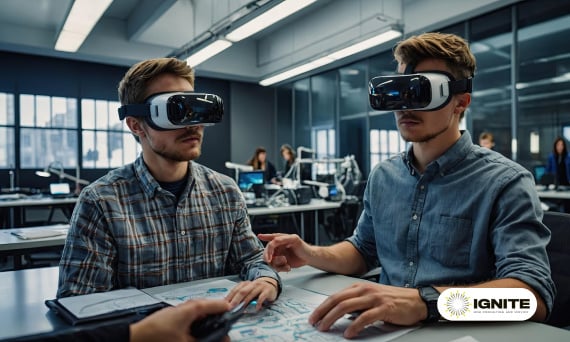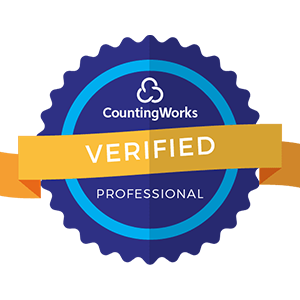
Imagine stepping into a virtual factory floor and learning to operate complex machinery. Or practicing emergency response procedures in a simulated crisis scenario. This is the power of virtual reality (VR) and augmented reality (AR) technologies to revolutionize employee training. VR and AR are poised to transform how companies onboard, upskill, and develop their workforce in realistic yet safe digital environments.
"Immersive technologies like VR and AR will be a game-changer for learning and development," says Rachel Lanham, Chief Operating Officer at Pixvana, a VR training solutions provider. "Employees can learn by doing in true-to-life simulations. The experience and muscle memory gained will translate to better performance and retention in their actual roles."
The business case for adopting VR/AR corporate training is compelling:
"The return on investment is significant - VR training is more effective and efficient. Companies see reduced error rates, faster time to productivity, and cost savings. The benefits are measurable," explains Thomas Muender, Head of AR/VR Learning at German railway company Deutsche Bahn.

VR training immerses employees in a computer-generated 3D world, allowing them to interact naturally using headsets and controllers. AR overlays digital information onto the real world through smartphones, tablets, or smart glasses. Here's how these technologies accelerate skills development:
VR/AR shifts training from passive to active learning. Instead of reading manuals or watching videos, employees learn by doing in realistic virtual environments. Immersive simulations engage visual, auditory, and kinesthetic senses to cement knowledge. Research shows we retain 10% of what we read, 50% of what we see and hear, but 90% of what we experience ourselves.
"Immersive technologies activate multiple areas in the brain related to information processing, problem solving, and motor control. This strengthens neural connections and memory recall. You could say VR/AR 'hacks' our brain's learning processes," explains Dr. Angelica Lim, Director of the Robotics and Embodied AI Lab.
Immersive simulations provide a safe space for employees to make mistakes and learn from them without real-world consequences. Retail associates can practice de-escalating tense customer interactions. Surgeons can refine new operating techniques. Firefighters can train for dangerous situations without putting lives at risk.
"In VR, the stakes are lower but the learning potential is exponentially higher. Employees can fail forward and develop both competence and confidence before applying skills on the job," says Bharani Rajakumar, founder of TRANSFR VR.
VR/AR allows employees to move through training modules at their own pace, repeating lessons until they achieve mastery. Immersive technologies can also personalize the learning experience, adapting content difficulty and focus areas based on individual progress and aptitudes.
"One-size-fits-all training is outdated. With immersive technologies, we can tailor training to the needs of each employee, identify knowledge gaps, and track skills development over time," says Amy Peck, founder and CEO of EndeavorVR.

Forward-thinking companies across sectors are harnessing VR and AR to rethink employee training:
Walmart uses VR to prepare employees for the chaos of Black Friday sales. Associates experience the rush virtually, practicing managing long lines, answering customer questions, and prioritizing tasks in a hectic environment. The company has also rolled out 17,000 VR headsets to train employees in three key areas: new technology, soft skills like empathy and customer service, and compliance.
Aircraft manufacturer Boeing trains factory workers to assemble wings using AR. Trainees wear smart glasses that display step-by-step instructions and diagrams directly in their field of view. With AR guidance, employees correctly complete tasks 90% of the time, compared to 50% using traditional 2D drawings. Training time has been cut by 35%.
Johnson & Johnson Institute harnesses VR simulations to train surgeons on new medical devices and techniques. Surgeons can practice in realistic virtual operating rooms before performing procedures on patients. VR training has improved surgical technique scores by 230% compared to traditional methods.
Luxury car maker Porsche leverages AR to upskill auto mechanics 40% faster. Using AR glasses, mechanics access vehicle service information, view parts numbers, and see repair instructions while working hands-free. Porsche has cut service resolution time by 40%.
The New York City Police Department is piloting VR to train officers in implicit bias, de-escalation, and crisis intervention. In immersive simulations, officers practice tense encounters, choosing the best responses to volatile situations. The goal is to improve decision-making and reduce the need for force.

To reap the benefits of VR and AR training, consider these best practices:
As VR and AR technologies mature, expect to see even more realistic and impactful training experiences. Advances in haptics will allow trainees to feel tactile sensations, like the recoil of power tools or the texture of fabrics. More natural interfaces using hand tracking, eye tracking, and voice commands will deepen immersion. AI-powered virtual humans will serve as relatable training coaches and roleplay partners. 5G networks will untether VR/AR experiences, enabling immersive learning anytime, anywhere.
"In the future, immersive learning will be as commonplace as e-learning today. VR and AR will be essential tools to attract, develop, and retain top talent," predicts Isabel Tewes, head of VR enterprise ecosystem at Meta (formerly Facebook).
As the battle for talent intensifies, companies that harness immersive technologies will gain a competitive edge. VR and AR training will become table stakes to meet the learning needs of a new generation of workers who expect engaging, personalized, and tech-forward experiences. Enterprises that fail to adopt these innovative approaches may struggle to build the skills and capabilities required to succeed in the future of work.
So rather than asking if VR and AR have a place in your corporate learning strategy, the real question is: can you afford not to embrace immersive learning? The future is already here - and it's time to step into it.


